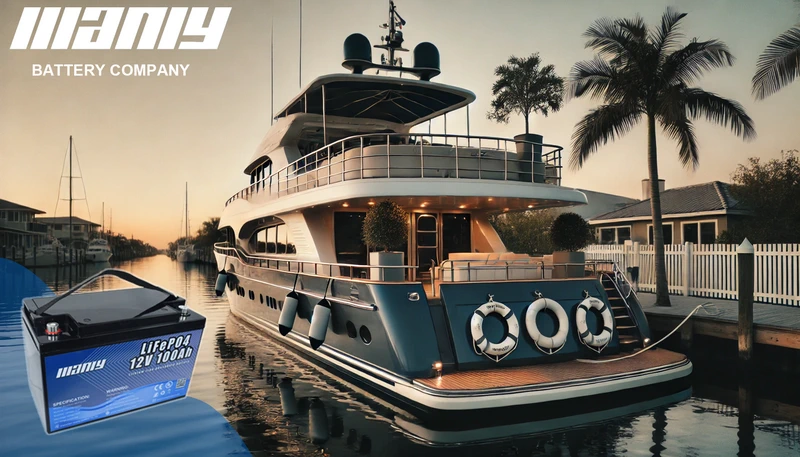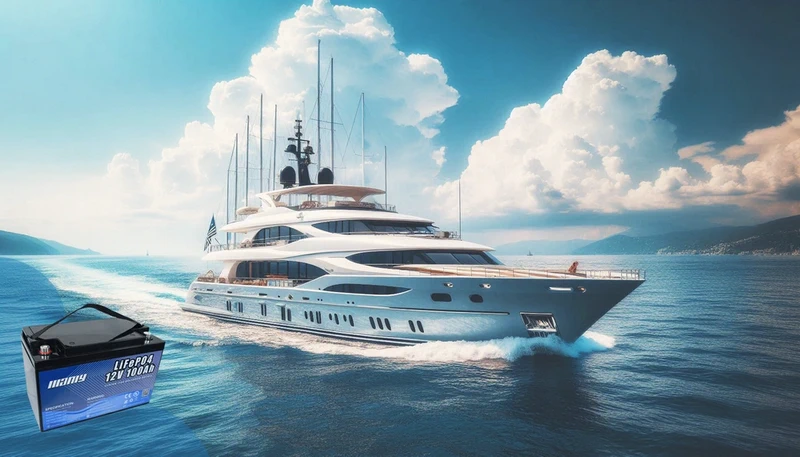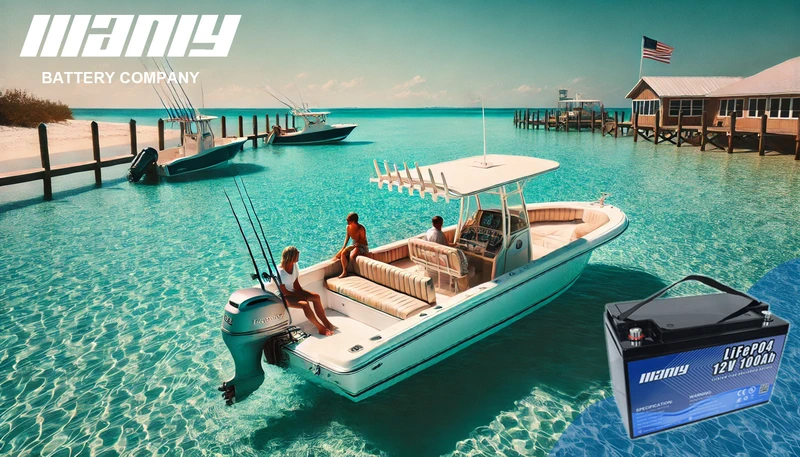Uma bateria marinha é um ciclo profundo? O que você precisa saber
Índice
- Uma bateria marinha é um ciclo profundo? O que você precisa saber
You’ve probably heard about lithium marine batteries lately—maybe you’ve even considered switching to them for your boat. Why all the buzz? As boaters demand more power, efficiency, and durability from their energy sources, lithium batteries are stepping up to the challenge. Lithium options offer a longer lifespan, lighter weight, faster charging times, and better overall performance than traditional lead-acid batteries. In this article, we’ll explain everything you need to know about marine batteries and why lithium is quickly becoming the go-to choice for boaters.
Types of Marine Batteries: What You Need to Know
1. Dual Purpose Marine Batteries
Key Features and Uses
Let’s start with dual purpose marine batteries—these guys are a bit of a jack-of-all-trades. They’re designed to start your engine and run your boat’s accessories. So, this is your best bet if you need a single battery that can hold a burst of power to kickstart your engine and run things like lights or a fish finder.
Benefits for Boat Owners
The beauty of dual-purpose batteries is that they save you space and money. Instead of buying separate batteries for starting and deep-cycle use, you get the best of both worlds in one package. But remember, if you’re out on the water for long stretches and are using your boat’s electronics heavily, these batteries might not last as long as a dedicated deep-cycle option.
2. Deep Cycle Marine Batteries
Characteristics and Applications
If you plan on using your boat’s electronics for extended periods—like a trolling motor for hours on end—you’ll need a deep-cycle marine battery. These batteries are built to be discharged and recharged repeatedly without compromising lifespan. Deep-cycle batteries are ideal when your boat’s power needs are more consistent over long periods.
When Deep Cycle Batteries Are Ideal for Your Boat
You want a deep-cycle battery if you’re out fishing for hours, running your trolling motor, or just enjoying a day on the water with lots of lights and gadgets. It’s perfect when you need to drain the battery over time and still get reliable performance without worrying about losing power halfway through your trip.
3. Starting Marine Batteries
How They Differ from Deep Cycle and Dual Purpose
Marine batteries are designed for one specific purpose—starting your engine. They’re built to provide a quick, high-power burst of energy to get your boat’s engine going. However, unlike deep-cycle batteries, they’re not made to be drained and recharged repeatedly, so using them for prolonged power output can damage them.
Key Uses for Starting Batteries on Boats
If your boating activity mainly involves quick trips or short outings where you’re primarily starting your engine and not using many electronics, a starting battery is exactly what you need. These batteries are about getting your engine up and running—no frills, just pure starting power.
4. Trolling Motor Batteries
What Sets Them Apart?
When it comes to trolling motor batteries, they’re the marathon runners of the marine battery world. These are deep-cycle batteries but designed explicitly for trolling motors. Why? Because trolling motors draw power over long periods at a steady rate. Trolling motor batteries are built to handle this demand, keeping you on the water longer without worrying about battery drain.
Why Specific Batteries Matter for Trolling
Not all batteries are created equal, especially regarding the demands of a trolling motor. Trolling motor batteries are designed to deliver a consistent power flow without the performance drop you might get from other types of batteries. Este means you can keep moving without worrying about sudden drops in power, which is crucial for fishing, boating, or any other extended on-water activity.
Why Lithium Batteries Are Gaining Popularity in Marine Applications
1. The Rise of Lithium Marine Batteries
Lithium batteries are making waves in the boating world, and it’s easy to see why. They’re lighter, more efficient, and last far longer than traditional lead-acid batteries. Lithium batteries charge faster, take up less space, and provide more consistent power. As boating enthusiasts look for reliable, high-performance solutions, lithium marine batteries are quickly becoming the future of boating power.
2. Benefits for Boating Enthusiasts
Lithium is hard to beat if you’re looking for a reliable, low-maintenance battery that can withstand long days on the water. Lithium marine batteries offer high energy density, which packs more power into less space. So, your boat remains lighter, which translates to better fuel efficiency and performance.
Another big perk? Lithium batteries last significantly longer than lead-acid batteries. While a lead-acid battery might last you a few years, a lithium battery can last up to 10 years or more, making it a worthwhile investment if you plan to get much use out of your boat.
3. How Lithium Compares to Lead-Acid Batteries
When it comes to lithium vs. lead acid, the differences are clear. Lead-acid batteries are heavier and less efficient and degrade over time, meaning they lose their ability to hold a charge. Lithium batteries, conversely, are lightweight, charge faster, and maintain their performance much longer. Lithium batteries cost more upfront, but the long-term savings from fewer replacements and lower maintenance make them a solid investment.
4. Cost vs. Longevity
Here’s the deal: lithium marine batteries cost more initially, but you’ll likely save money over time. With their longer lifespan (typically 2-3 times that of lead acid), you won’t have to deal with frequent replacements or maintenance, and they’re more energy-efficient. Ultimately, the higher upfront cost is offset by the longer-lasting value.
5. Weight and Efficiency Considerations
Let’s not forget about weight. Lithium marine batteries are lighter than their lead-acid counterparts, which is a huge bonus for boaters trying to reduce their vessel’s weight for better fuel efficiency or handling. Plus, they’re more efficient, meaning they deliver more power per pound than lead-acid batteries, allowing you to maximize your boat’s performance.
Escolhendo a bateria marinha certa para o seu barco
1. Understanding Battery Sizes and Power Needs
Choosing the right marine battery starts with understanding your boat’s power needs. Are you using your boat for short trips with minimal electronics? Or are you out on the water for extended periods, using a trolling motor and powering multiple devices? The right choice will depend on how much power you need and for how long.
2. Matching Battery Capacity with Boat Requirements
Not all boats are the same, so matching the battery’s capacity to your boat’s power needs is essential. Whether you choose a bateria de lítio or a more traditional option, make sure the battery can handle the load your boat requires, ensuring reliable performance when you need it most.
3. Which Battery is Best for Your Use Case?
Should you go for a dual-purpose battery, a deep-cycle battery, or a dedicated starting battery? That depends entirely on how you use your boat. If you want an all-in-one solution, a dual-purpose battery might be ideal. But for those who rely heavily on electronics or trolling motors, a deep-cycle battery (especially lithium) is the way to go.
How to Maintain and Charge Your Marine Battery
1. Charging Lithium Marine Batteries: Best Practices
O equipamento certo é essencial quando se trata decarregando baterias marítimas de lítio. Use um carregador projetado especificamente para baterias de lítio para garantir que você esteja aproveitando ao máximo a duração da bateria. Carregue sua bateria regularmente, mas evite sobrecarga, pois isso pode reduzir a vida útil da bateria.
2. Tips for Extending Battery Life
Armazenamento adequado e manutenção regular são essenciais para aproveitar ao máximo o seuBateria marinha de lítio. Guarde a bateria em um local fresco e seco e verifique regularmente para evitar problemas.Esteajudará a prolongar sua vida útil e garantirVocê está pronto para bater na água quando chegar a hora.
3. How to Store Marine Batteries
O armazenamento adequado é fundamental para manter seubaterias marítimasEm boas condições. Verifique se suas baterias estão armazenadas em umtemperatuthat'strollede localização seca quando não estiver em uso. Evite deixá -los em calor extremo ou condições de congelamento, pois ambos podem afetar significativamente seu desempenho.
Conclusão
Mudando paralithium marine batteriesPode ser uma das melhores decisões que você pode tomar para o seu barco. Eles são mais leves, mais duráveis e duram muito mais que as baterias tradicionais de ácido chumbo, tornando-as um investimento fantástico a longo prazo. No entanto, o custo inicial pode ser maior, por isso é importante pesar isso contra os benefícios da longevidade, eficiência e custos de manutenção reduzidos.
Por que o lítio pode ser um bom investimento para o seu barco
Se o lítio é a escolha certa depende de suas necessidades de barco. Nada pode dar errado com as baterias de lítio se você estiver procurando desempenho, confiabilidade e valor de longo prazo. Eles podem custar mais adiantamentos, mas estarão a longo prazo com menos substituições, melhor eficiência e mais tempo gasto desfrutando do seu barco.
FAQ
1. Is There a Difference Between Deep Cycle and Marine Battery?
Sim, há absolutamente! Vamos quebrá -lo em termos simples. Uma bateria de ciclo profundo é o corredor de maratona do seu barco - construído para lidar com descargas e recarga profundas por longos períodos. É ideal para alimentar eletrônicos, luzes e motores que precisam de energia consistente durante passeios estendidos. Por outro lado, uma bateria marinha é um termo mais geral que abrange todos os tipos de baterias usadas em barcos, incluindo ciclo profundo, baterias iniciantes e de uso duplo.
As baterias de partida são como velocistas - explosões rápidas de energia para disparar o motor, mas não devem lidar com o longo curso.Baterias de dupla fura? Bem, eles combinam o melhor dos dois mundos, dando-lhe o poder de iniciar o motor e executar seus eletrônicos, mas eles não brilham quando você precisa de uma bateria que possa lidar com o uso de longo prazo e de serviço pesado. Portanto, saber a diferença ajuda você a escolher a bateria certa para suas necessidades específicas na água!
2. How Do I Know if My Marine Battery Is Deep Cycle?
Quer saber se sua bateria marinha é um ciclo profundo? É muito fácil descobrir. Primeiro, verifique o rótulo. Muitos fabricantes exibem orgulhosamente se a bateria é uma bateria marítima de ciclo profundo na frente. Se o rótulo diz "ciclo profundo", é uma grande pista! As baterias de ciclo profundo são projetadas para descargas frequentes e profundas, para que sejam perfeitas para viagens mais longas quando você está executando eletrônicos, luzes ou até motores de trolls.
Outra dica? Se você estiver usando a bateria para energia contínua (pense: longas horas de pesca ou manter os sistemas do seu barco em funcionamento), provavelmente é um ciclo profundo. As baterias iniciantes, por outro lado, são destinadas a rajadas curtas e intensas para iniciar o motor e não têm a mesma durabilidade para descargas profundas.
3. What Type of Battery Is a Marine Battery?
Quando falamos sobre uma bateria marinha, estamos falando de uma família inteira de baterias que os barcos hidráulicos. Não há apenas um tipo, e cada um tem seu próprio papel a desempenhar para manter seu barco funcionando sem problemas.
Aqui está um rápido colapso dos principais tipos de baterias marítimas:
Baterias marítimas de ciclo profundo: Eles são projetados para fornecer energia consistente por longos períodos. Eles são perfeitos para executar coisas como motores, luzes e eletrônicos inteiros durante viagens prolongadas. Se você precisar de energia para um longo alongamento, este é o seu objetivo.
Iniciando baterias marítimas: Essas baterias são feitas para fornecer uma rápida explosão de energia para iniciar seu motor. Eles são ótimos para viagens curtas, onde você não precisa executar eletrônicos por muito tempo, mas precisará de algo poderoso o suficiente para que seu motor anda.
Baterias marinhas de dupla finalidade: Uma combinação dos melhores recursos, tanto do ciclo profundo quanto das baterias de partida. Isso é ideal se você precisar de um pouco de ambos-iniciando o motor e executando alguns acessórios, mas eles podem não se sustentar tão bem quanto baterias dedicadas ao longo do tempo.
Cada um desses tipos de bateria tem seus pontos fortes, e saber qual escolher depende de como você planeja usar seu barco. Se você está fora para um fim de semana de pesca ou um dia de cruzeiro, a seleção da bateria marinha certa manterá seu barco ligado pelo tempo que você precisar.








